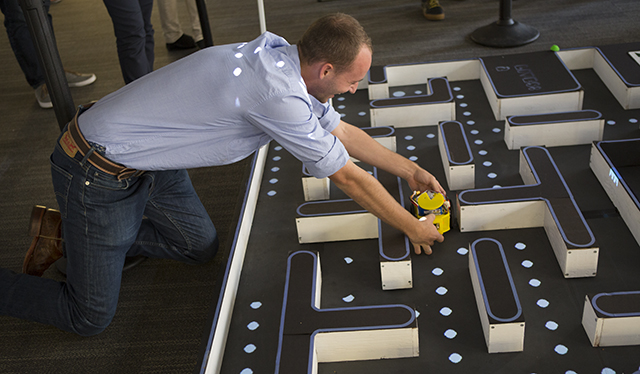
Harvard robotics club re-engineers PAC-MAN for the 21st century
The Harvard Undergraduate Robotics Club (HURC) is bringing high tech robotics to old school gaming.
On Saturday, April 28, four teams descended upon the Harvard Student Organization at Hilles (SOCH) for the second annual “PacBots Competition.” The challenge: design a robot than can move autonomously through a PAC-MAN style game board, use cameras to sense direction and obstacles, operate well enough to collect “pellets” throughout the course for points, and avoid the classic angry ghosts..
PacBots teams from the John A. Paulson School of Engineering and Applied Sciences student organization HURC, Columbia University, and University of Texas at Austin, as well as a local engineer/alumni team, were treated to speeches from representatives at Amazon Robotics, Analog Devices, and MIT Lincoln Labs to start the afternoon. The competition followed.
The HURC PacBots team has been preparing for this moment since the beginning of the school year.
“We had two main projects: the computer vision side and the bot site,” explained Lyra Wanzer, S.B. ’19, a mechanical engineering concentrator. “We had a large team of computer scientists coding for the robot and the game projections for the course, and a smaller mechanical and electrical engineering team working on the robot itself. The most fun part was working so closely with these dedicated members of SEAS, especially in the weeks closing in on the competition.”

Timothy Tamm, A.B. ’18, a computer science concentrator, places the HURC Pac-Bot skillfully on to the board for its first run. (Photo by Alana Davitt/SEAS Communications)
The competition setup had an entire control center, with multiple computers connecting the video game to the overhead projectors and cameras, and servers connecting the robots back to the computer code dictating their behavior throughout the course.
Each team had a different strategy for earning the most points and successfully navigating the PAC-MAN board. HURC’s robot was designed to know its position, that of the nearby ghosts, and whether it had collected any power pellets.
Project Manager Charlie Colt-Simonds, S.B. ’20, an electrical engineering concentrator, explained some improvements the team has made to their robot in the second year.
“We moved to a printed circuit board-based design rather than a 3D-printed chassis, which is more reliable and has less weight,” he said. “We also faced our sensors diagonally outwards so the robot can tell what is in front as well as behind it. And it has the capacity to drive forwards and backwards.”
The alumni team, on the other hand, composed of former HURC member John Holland, S.B. ’17, a mechanical engineering concentrator, had a different strategy. His bot only knew to correct direction by the sensor on the front bumper, and used simple directional codes.

Alumnus John Holland, S.B. ’17, a mechanical engineering concentrator sets up his “Fly Navy” robot. (Photo by Alana Davitt/SEAS Communications)
Despite the friendly competition, there was a tangible sense of pride and team spirit among the engineers and coders. Freshman Robert Jomar Malate joined the robotics team to gain more computer science experience. He learned many new skills while designing aspects of the game visuals and a target on the robot so the cameras could better track its movement.
“In HURC, even though you’re new, they’re welcoming and eager to teach you,” he said.